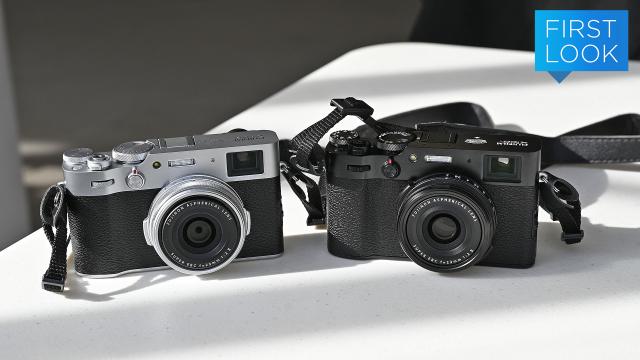Cameras on phones have gotten pretty good over the last few years (especially the ones with multiple rear lenses), but sometimes you just want something that snaps pics with a bit better quality, and with the new X100V, it feels like Fujifilm has made an everyday travel camera that fills the gap between phones and cameras with interchangeable lenses just right.
Sporting a 26.1-MP sensor and an X-Trans CMOS 4 processor, the $US1,400 ($2,079) X100V shares a lot of traits with the more expensive $US1,800 ($2,673) X-Pro 3, including its hybrid viewfinder. But where things diverge is that instead of offering an interchangeable lens mount, the X100V comes with a fixed 23mm f/2 lens that helps the X100V offer a lighter and slightly smaller body.
Note: The X100V we tested was a pre-production device, so there may be differences in software or image quality between what you see here and final retail devices.
That doesn’t mean it’s similar to cheaper cameras like the Ricoh GRIII or Sony RX100 series. Those are more standard compact cameras while the X100V is intended to be a pricier travel camera with an actual range finder.
To enhance the X100V’s travel cred even further, Fujifilm has added weather resistance to the X100 line for the first time. Fujifilm says that the X100V’s body is fully weather-sealed, with the only potential place where water can enter the camera being the front of its lens. However, if you tack on the X100V’s optional AR-X100 adaptor ring and a filter, you can make the whole thing weather resistant.
But what might be the biggest upgrade on the entire camera is X100V’s new 3-inch rear display, which supports touch controls and comes on a tilting two-way hinge so you can use it to help compose shots taken at awkward angles, or even snap the pic itself using the camera’s touch shutter.
Elsewhere, Fujifilm has made a couple other smaller tweaks including switching from magnesium to aluminium for the top and bottom parts of the camera’s frame, and moving the programmable Q button to the very edge of the X100V’s back so that it’s less prone to accidental presses while still being easy to reach.
[referenced url=” thumb=” title=” excerpt=”]
However, it’s the combination of all these different upgrades that make the X100V really appealing, as it’s basically a simpler, more compact, and less expensive version of X-Pro 3, while still delivering practically the same experience. The X100V even has support for 4K video captures at up to 30 fps, though because the camera doesn’t have a dedicated headphone jack for monitoring audio levels, it’s not really designed to be your primary video cam.
Thanks to its hybrid viewfinder, the X100V still feels very much like a traditional rangefinder camera, but with modern sensibilities. That’s because, alongside the optical viewfinder which features a 0.52x magnification and 95 per cent coverage, the built-in EVF lets you see a digital live view in the bottom corner of the viewfinder.
The X100V also has the same selection of Fujifilm’s wide selection of film grain simulations as you get on the X-Pro 3, which can be easily mapped to the control ring on the front of the camera’s lens for quick access. Additionally, the X100V’s ISO dial has been slightly redesigned for better ease-of-use, because now it’s locked by default, and to change your ISO you have to lift up on the dial instead of moving it up and down to lock and unlock all the time.
And on top of all that, the X100V also has a built-in ND filter, which is essential when shooting in bright daytime conditions. Between the X100V’s wide f/2 lens, ND filter, and its updated sensor and processor, you basically have everything you want in a great travel-friendly camera.
However, the one thing I wish Fujifilm did a bit better is the X100V’s joystick. I’m happy that it’s there, but especially on cold, wintery days like I experienced during this preview, the small and stubby joystick feels somewhat stiff and is harder to control than what you get from a lot of other camera makers.
But aside from that, the X100V focuses fast, give you lots of options on how to compose your shots, and it’s image quality rewards you for carrying around something other than just your phone.
For me, the image that was the biggest reminder of that was a shot of some graffiti and torn up stickers. The level of detail you can see across all the various textures is a real treat, while in more typical shots, the X100V impressed with sharp focus and a solid dynamic range. And while I didn’t have a chance to test them out, in case you’re worried about the X100V’s fixed 23mm lens being a bit too limiting, Fujifilm also offers separate 28mm equivalent wide-angle and 50mm telephoto conversions lenses.
So while the saying goes that the best camera is the one you have with you—which is typically your phone—the X100V is a nice reminder that there’s still plenty of room in people’s lives for a compact travel cam that’s worth the added weight.
The X100V will be available in black or silver for $US1,400 ($2,079) starting in late February in the U.S. There is no currently confirmed Australian price or release date.
